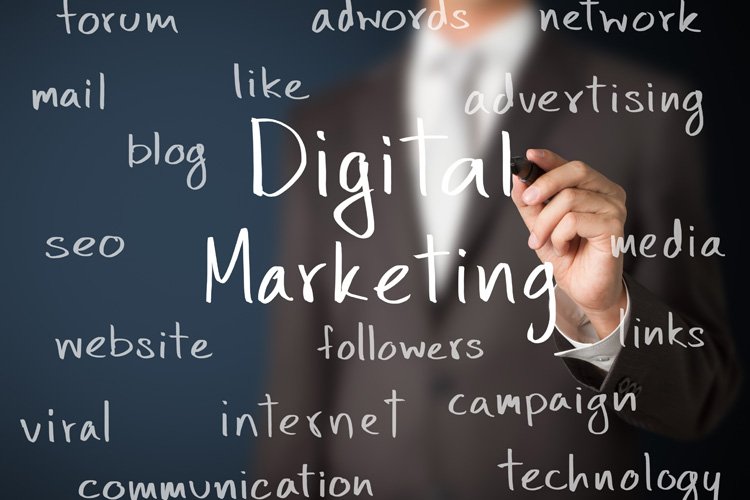Marketing
Stand out from the crowd
As we grow and develop we realise that to be different is not only a good thing but it’s necessary. It can’t be any truer than in the world of business. Finding ways to be different enough to be remembered is what advertisers call “cut through” and it’s that point of difference that a business uses to get it’s message read, voice heard and products sold.
People who could be prospective customers are constantly bombarded by many messages every day from thousands of businesses wanting a share of their wallet. Potential customers log into their Facebook, upload on Instagram, read the online news and open up an app. Then they take the journey outside their front door and see messages are plastered on billboards, buses, trains, trams, bus shelters, magazines, flyers and handouts and street giveaways.
Buy this new thing - it’s perfect. Buy this other one - it’s 20% this week. Want to look like these people in this ad? Are you up with this new device? It’s never ending.
The problem is we learn to block out or dull down the “noise” created by advertising because on average one person can now receive anywhere between 4,000 to up to 10,000 advertisements per day (1) .
Are you worth noticing?
When a business is asked “what is it about your that makes you different” the real question is “what is it about your product/service/business that is worth attention”. A business’ advertising and marketing can only work as hard as the information that it is given. If there is nothing that is solely and completely unique about the business then it will invariably be placed in a “copycat” category and placed below those that more superior in the market. The One Week At A Time video referenced the book called Purple Cow by Seth Godin, who wrote the book to help Business Leaders think about themselves and their business differently. The interesting thing that he had to say (among many ideas) is that “marketing is the art of building things worth noticing”. The job of the Business Leader therefore is to look around and find that “one thing” that will make a customer remember them.
How to find your ‘different’
Now it’s all been said many times before. Find your Unique Selling Proposition. Everyone talks about their USP but do we really know what they are? The quick meaning of USP is - it’s a marketing message that makes it super easy for the customers to know who they are and what they stand for. There are many words that can be picked on to express this such as “best quality”, “fastest service”, “widest range”, “best variety”, “innovative” and so on. All of which are meaningless without a story. A good business can become great when they create stories. Here are 5 simple ways to find out the point of difference and the story:
- Original founders.
When was it founded? By whom? What was that person like? (special attributes are memorable). These people can add gravitas to a business, especially ones which needs to ground itself historically and quickly. Longines (high end premium brand) markets themselves as having heritage as far back as 1945. Rod Laver Arena is an internationally known Melbourne sports centre using the famous Australian tennis player as its namesake - forever adding cache and kudos to its venue. - Original Seeds.
When you first started out what was the one thing customers all said they liked and wanted? Sometimes we lose sight of the core reason we started a business, and often, going back to the very beginning can provide good information. A street food supplier may have forgotten that its customers absolutely love their soups and would line up for hours (if it ain’t broke don’t fix it!). - Individual style or attitude.
If the business was a person, what kind of person would that be? (this is a brand building question but also works well with USPs). Think about people who are used as the “face” of a company. George Clooney, Richard Branson, Kate Moss, Pat Cash - they have been the style and attitude on front of the Nespresso, Virgin Empire, Calvin Klein and Bonds products and services. Personalities lend their existing popularity and unique following to companies to show an aspirational person using the product (prompting the unconscious “I want to be like them” response). - Emotion.
Where in your business do you create emotion in people? How do customers gravitate to you? Ask them. You’ll be surprised in some businesses how important this element can be. As people we like to feel we have invested our money and in return gained something more than a transaction. Think about what added experience the business provides customers where they leave with a “feeling” as well as a product or service. - Disruptors.
The tech world are full of them! Life hacks. Body hacks. Dad hacks. It’s a growing trend that isn’t going away. Ask this of the business - does it provide a disruption in the market that will change the way people currently live?
These suggestions are only a small snapshot of how to think differently. Like in life and so it is in business - we can only be the people that we are and give what we have.
The global market tends now find consumers demanding this sense of authenticity. Of being who you are and doing it well. That’s why it is even more important in business today than in previous times to find what it is to be different. After customers learn what the business is about and what it is “famous for” the possibilities are endless. The USP can be applied to many other areas of operation (not only marketing and advertising) allowing the business to expand and grow in a completely unrepeatable ways separate from its competitors. A Business Leader needs to emphatically seek to out that one area that all customers, staff, partners and suppliers can identify with. Find out what, inside the business is only “theirs”. Then own it. Say it. Live it. Breathe it. That’s how to truly stand out from the crowd.
Resources
If you would like to discuss how you can boost your conversion rate for your particular business situation please contact Brett Burden, Senior Business Coach on 1300 971 763.
References
(1) http://www.redcrowmarketing.com/2015/09/10/many-ads-see-one-day/
Marketing Spend
Ask any Marketing Professional, Advertising Consultant, Digital Guru how much a business needs to spend on marketing, and the response usually goes something like this... “it depends on your budget, who your target market is, what the marketing is for, what you want to achieve, what mediums you want to use …..”. What they really mean to say is - how long is a piece of string. It’s not a mystery so much as a puzzle when we talk about marketing budgets. Answering that question for business involves finding the right information to piece together that puzzle. The spend on marketing is largely dependant the product or service category a business is playing in (for example, high demand high involvement products have different needs to low demand, low involvement products).
Explosion of choice
What to spend marketing funds on is based on, depends on how people generally consume information everyday. The way that we are advertising and displaying information to each other now, is predominantly digital. This is backed by the AC Nielsen report (1) which showed in 2015 Australian businesses spent $AUD6 billion on digital advertising (growing at 25% year-on-year). With a significant spend in all other ways to advertise but no more so than digital (broken out into three areas: search, display and classified ads). In the same year $AUD 1.25 billion was spent on mobile phone advertising, followed by $AUD 3 billion on metropolitan television, and $AUD 2.1 billion on printed newspapers.
Piece of the pie
It’s clear Australians want to consume their media online and the burning question that a Business Leader want to know is - how much will it cost. How much of their revenue is required to seen, heard and remembered. The team at One Week At A Time have a basic rule of thumb for small to medium size businesses who haven’t an endless supply of marketing dollars and/or marketing teams to support their business. We believe that the budget should be based on a percentage of sales revenue, dependant on the industry and competitive activity. It’s a “broad” definition but a realistic one.
The actual percentage can change dramatically. For established business it may be 5-6% of sales revenue. Start-ups on the other hand, are likely to spend 200%+ of sales revenue. The point is, whatever the situation, the budget needs to be split like this:
- 40% of total spend on advertising and marketing on New Clients
- 60% of total spend on advertising and marketing on Existing Clients
Retain to sustain
Retention strategies often get ignored in business. The assumption that the current customers are satisfied and likely to return back to the business is a misguided notion. Retaining customers, creating strategies to keep them coming back again and again, is the lifeblood of small to medium sized businesses. Customers who are likely to spend more with a business are those who have established a relationship, who know the product already, and who have had more than one positive service experience. Placing 60% of the advertising and marketing budget their way is put very plainly: good business practise.
Back to the piece of string
We know we need a budget for marketing and advertising (how to do customers know you exist if you don’t tell them?). And we also know what kinds of ads to be buying - online and aimed largely at the current customer base. The length of the string now becomes shorter. All that’s left is to work out these questions(2):
- What do I need to get out of my advertising/marketing? (leads, sales, awareness?)
- How much are you currently paying to compete? ($2000, $10000 etc)
- How fast can I afford to grow?
- Can I take on the risk? (marketing is a social experiment, are you okay about that?)
- Can I gather statistics to minimise risk? (Pay per click, User Experience, Foot Traffic, Eyeballs etc - information on how many people the advertising is likely to be shown to)
It’s also very useful to find out how much the competition is paying to compete in the same market conditions(3). For example, how much top advertisers and top industry advertising categories are spending in overview reports(4).
Alternatively, for small to medium sized businesses check what the specific benchmarks are for the industry. The most useful information can be found on Australia’s Benchmarking Data and Research site(5). The detailed report on specific industries will show a host of information such as the average gross fees, gross profit, annual turnover, staff hours, staff hourly rates and the average advertising and promotional spend. A sample report can be viewed here(6).
Be in it to win it
Once a Business Leader is regularly placing a reasonable budget aside to use in marketing and advertising, perhaps assign an internal Team Lead test and measure each campaign and each placement. Find out what the customer base for the business responds to best. Throwing your hat in the ring doesn’t mean going into it blindly. Measuring the sales revenue increases from each sales campaign will provide a baseline for competing. Remembering all along, to get the highest share of wallet and be known in any market - you really do have to be in it, to win it.
(1) http://www.adnews.com.au/news/where-s-the-money-going-exclusive-ad-spend-trends-report
(2) https://www.forbes.com/sites/entrepreneursorganization/2015/03/06/marketing-budget-for-small-businesses/#f24d9bf2fdba
(3) https://www.deloitteaccesseconomics.com.au/uploads/File/Connected%20Small%20Business.pdf
(4)
http://www.oma.org.au/facts-and-figures/industry-performance
(5) http://www.benchmarking.com.au/australianbenchmarkreport
(6) http://media.wix.com/ugd/cef76d_f02e6712262a4006b83e1c817c90491f.pdf
Measuring quality not quantity
When it comes to testing and measuring marketing, it isn’t hard to be caught up with the dazzling statistics of how many people responded to a promotional campaign. Information can be found on the number of marketing levels such as comments, eyeballs, visitors in-store, household circulation, usage. That is all very well and good, however Business Leaders, especially those of small to medium size enterprises, will need to know how their carefully allocated marketing dollars are working to grow their business. Marketing can be used for a number of things - build a reputation, reinforce a choice, introduce new concepts - but the main use for marketing activities is to generate leads.
Generating leads can be costly as we heard in the One Week At A Time video where, for one company, the yearly telephone directory advertising cost them approximately $AUD27K annually to maintain. So the real question here is which activity will generate leads where the conversion rate is the highest? In this paper we will explore how measuring incoming leads can relate directly to the number of sales conversions.
Metrics made easy
When a business chooses a way to promote their product or service, that way, or “channel”, has a unique set of measurements to find out the level of responses it can obtain. For online activities like Google AdWords, Facebook Advertising, Online banner ads, the measurement include click throughs, likes and followers. For Radio they measure that by how many listeners tune in. When it comes to events we talk about measuring the number of visitors or attendees.
After we look at the various terms of measurement the easiest way to approach all the of them is to simply look at the number of sales enquiries the business gained during the period of promotion. Let's call those enquiries "leads". Then ask those leads how they heard about the business, in other words, "qualify the lead". This way we (a) flag them as a lead (b) check they have been in contact with one of the marketing promotions.
There are only a few ways marketing activity can incite action in people to turn them into leads. Marketing directly communications that a person should call (telephone number), visit (come in-store and speak to a sales person face-to-face) or click a button (online purchase). Marketing is used to create those lead opportunities for the sales team to be able to convert them into concrete sales.
Conversions count
To measure leads against conversions, first list out the different ways the business currently promotes its product or service, examples may be:
Business-to-consumer
| Marketing Method | Leads Per Channel | Conversions |
| Email campaigns | 120 | 50 |
| Referrals from customers/clients | 10 | 8 |
| Events | 300 | 20 |
| Flyers | 80 | 53 |
| Google Search engine (SEO) | 210 | 36 |
| Newspapers | 238 | 16 |
| Radio | 20 | 0 |
| TV spots | 340 | 33 |
| YouTube Advertising | 89 | 3 |
| Website | 157 | 86 |
Business-to-business
| Marketing Method | Leads Per Channel | Conversions |
| Events | 10 | 1 |
| Account Manager Meetings | 43 | 5 |
| Tele-sales | 50 | 1 |
| Tenders | 1 | 0 |
Next to the marketing methods, list the total the number of enquiries (leads) each one brought in e.g. 120 enquiries from online, 20 enquiries from newspaper advertising, 50 enquiries from email campaigns. For business-to-business organisations total the number of clients who have demonstrated to ongoing conversations with the organisation (‘hot’, ‘cool’ and ‘cold’ leads).
Now list out the number of actual sales that have come about from each of the individual channels and focus on the channels that had the highest number of sales. This is slightly counter-intuitive as some channels may have a very high number of leads which business leaders automatically want to maintain, but the sales are not high.
For business-to-business organisations, total the number of clients who came on board and the main vehicle that was used. For example, account manager meetings gathered 5 clients, each committing to 2 year contracts, whereas, Tele-sales may have only gathered 1 client and used twice as much time and cost to gain that 1 client.
Once the best channel is found, it’s not that we turn off all others. It is much wiser dial it down the efforts in the other channels (especially if the competition are highly active), and simply boost up the more profitable one.
Business Leaders need to continually test out if those channels with a high number of leads are actually producing a high number of sales conversions. If they aren’t then consider using a different avenue to market.
For small to medium sized businesses who have found a positive combination of marketing activity by measuring in this way will see how quickly this method starts to make sense (and dollars).
Quality over quantity
The one problem with sending out promotional messages is that we don’t know if the market has cash to spend. When a product or service has a high price point, the competition for a share of that spending cash is fierce. Major credit card companies are known for working their marketing activities hard for a continual piece of weekly household disposable income. Businesses who market directly to the public need to be aware of their target market spending habits. The tighter the economy, the more competitive a business will need to be to gain access to those dollars from the household purse strings.
For business-to-business organisations the best way to analyse if a client or prospect has spare cash for suppliers is by tracking and receiving trend reports on their client’s performance in the market. Industry reports can be bought through reputable companies for each category. For example, car sales figures can be tracked through VFACTS, allowing suppliers to see which manufacturers are doing well and which are taking a downward trajectory.
Investing in testing and measuring
When a Business Leader is able to generate quality leads and a steady conversion rate the cost of marketing is no longer an expense, it is a valuable long term investment.
Measuring and testing out which combination of activities gets the best quality must be at the forefront of a Business Leader’s mind. Finding the best lead generators that produce the highest number of sales conversions is the fuel that feeds the engine of successful businesses.
References
Marketing Strategy (on a tight budget)
What is strategic thinking? It’s an activity that starts well before the first sale and continues well after the first sale. How does that translate into practical terms? There are two stages in strategy making. The first is planning and research, and the second is measuring and testing.
Stage 1
“Establishing favourable arrays and configurations (strategic posture) will provide you with the positional advantage (p21)...Managing a large group is no different from managing a small one if the organisation is sound (p32).”
- The Art of War by Sun Zi (translated by Dr Han Hoing Tan)
There are various aspects associated with Planning and Researching. Most people start with researching the product itself and understanding what they are selling. Earlier in One Week At A Time we talked about the Star Product (refer to Week 9). The Start Product is the one thing that the business loves doing and can sell as a unique product to them, that is profitable. Once this is determined, researching your Target Market (i.e. the best group of consumers that are suited to the Star product) and conducting a S.W.O.T. Analysis usually follows.
Target Market Research
To find out who is suited for your Star Product these are some of the best, most practical questions to ask:
Business to Consumer (B2C)
(if the product is directly aimed at a group of people)
- What is their average age?
- Are they majority Male/Female?
- Are they married? With or without children?
- Earning capacity?
- Where do they go out for entertainment?
- Do they own/rent/buy property?
- Where do they take their holidays? Do they work out (gym)?
- Where do they like to go out to eat? How often do they dine out?
- What kind of technology do they use?
- What social media are they one?
Business to Business (B2B)
(If the product is aimed at other businesses who on-sell it to consumers)
- What is target business’ size?
- What are their supplier policies?
- Do they go to tender? How often do they tender?
- What is their market position?
- Are they a large/medium/small player in their market?
- What are they lacking? Can you provide any unique product or service just for their business?
- Do you have many other suppliers jockeying for position to gain business with this company?
- Who are the gatekeepers?
- Who are the decision makers?
- How much business does this company represent to you?
- Are they in a position of power over your business?
Whether a business operates either B2C or B2B both variations need clearly defined products. A Business Leader will be required to clearly define the product they are marketing. Listing out the attributes (features) shows a manufacturing/servicing knowledge, and demonstrating how the features benefits the target market is essential. Ensure that in each marketing activity the business has shown how that Star Product provides a solution to a problem.
Lastly, when researching your Star Product and finding your Target Market, ensure the Start Product is delivered in a way/time/place that suits the target market. Simply adjust the business so it can connect with the Target Market’s habits. Knowing your Target Market and acting on the information about the Target Market’s world and habits will significantly increase the number of opportunities a business gets to sell to its products.
S.W.O.T. Yourself
SWOT stands for the Strengths (S), Weaknesses (W), Opportunities (O) and Threats (T) of a business, product or situation. Often call the “Situational Analysis” as it can be used as a ‘snapshot’ of what is happening (the situation) at a given point in time. The SWOT can be expressed as a list under each of the headings or as a table of comparison against another business, product or situation.
A SWOT is zero dollar cost to a business, and only requires allocating time for a team to get together and develop it. Certainly a highly valuable, strategic tool that can be refreshed and applied to businesses. It will return dividends by producing longer lasting profits and sustain a business through each period and cycle. SWOT’s are used by the whole business community from sole traders, start-ups and small businesses, all the way to massive multi-national worldwide organisations.
Stage II
Measuring/testing different strategies and fine tuning those strategies based on results will help grow a business into the long term. A business is much like a plant, it requires nurturing, checking, adjustment in order to find the optimum positions/best variations of light. Checking progress and being attentive means a business is always ready for the next opportunity to sell and to improve. If a strategy has not worked this time around - it doesn’t mean shelf that idea - it may work again under altered circumstances (e.g. try different timing, different price strategy, updated packaging etc).
Next week, we will discuss the specific measurements/data and what to do with it all. It’s important for a business on a tight budget to ensure that for every 1 dollar spent, 2 dollars comes back into the business (lead generation). The main point here, however, is to keep going.
Try different channels, try different times of the year and invent different events. Find out what really gets the responses of the Target Market for your products or services. Do they respond to your Facebook advertising? Are they calling your business more than emailing? Are they registering or buying via email campaigns? Do they buy your product mainly online? Do they prefer to speak with fuller sales discussions face-to-face? Whatever the preference, it will pay off in the long term when you find out what makes your Target Market tick.
Marketing and advertising allows consumers to know 2 major things: (a) the business exists and (b) the business is ready to service them!
Simple One Page Marketing Plan
A plan with all the above research information could wind up being 20, 30, 40 pages long and perhaps difficult to communicate back into the business. Placing thoughts in a short format can make it easier for time poor Business Leaders to pick out the main activities, and focus on delivering only the top marketing objectives.
One Week At A Time has devised a One Page Marketing Plan for small to medium sized businesses and their Business Leaders. It’s easy to understand, simple to use, and effective in helping teams get on board with the vision and the marketing strategy.
To find out how to simplify all the information from your marketing research into one document contact Action Centre via email admin@theactioncentre.com.au or email Brett Burden directly at brettburden@theactioncentre.com.au. Alternatively call 1300 971 763 to request a copy of the One Page Marketing Plan.
Use Marketing to Educate
Businesses know they have the opportunity to represent many things to a customer. Convenient (7 Eleven). Innovation (Apple). Friendly (Virgin Mobile). As part of the process of buying and selling businesses are constantly educating consumers. Savvy businesses are aware that when a consumer thinks about a business, they engage in a relationship where ask themselves “what can this business do for me?” “how can they solve my problem”. When you’re educating people, you’re helping them understand the benefit of a solution1.
Businesses make the mistake of trying to “tell” masses information about themselves (products, attributes, features, size etc) rather than explaining how they can improve their life as a result of their purchase with them.
Brands teach quickly
Consumers are time poor most of the day. They come into contact with many things in a day - family, friends, colleagues, clients. Then there’s Facebook, Twitter, online or TV news and emails. And that’s all before the 9 o’clock in the morning! Marketing create “brands” to relieve people of the burden of trying to find time. They create mental shortcuts for people to learn very fast what businesses are about. Businesses can use branding to educate consumers on:
- What they stand for (core philosophy)
- Why they exist
- Who they wants to cater to/service
- That they are trustworthy
- That they knows their stuff
- And that they are ready to help in a meaningful way.
Once a business has answered these questions, they have started the journey of educating their customers, that’s just part of the picture sorted.
Crafting your core messages
As we’ve previously mentioned, Marketing is a communication tool that exists across everything a business puts out there to the world. A clearly defined business prepares only the core messages for a society of time poor consumers.
What are the kinds of things businesses need to educate?
In this week’s One Week At A Time, Brett discussed the most important areas that a business uses to teach, they are:
- Brand Name.
Check that it doesn’t mean anything derogatory in another market or another language that could affect your business. Also ensure it’s not too obscure that people won’t remember the name.
- Brand Promise.
What does your business stands for? What sets them apart?
Don’t fall in the trap of writing a “tag line” and hoping that will work. The whole business needs to live up to what it says. Superior customer service? Ensure every customer interaction makes that true. A brand promise is your promise to the customer that you can live up to, which explains your niche in the market. It is written as a paragraph, and it is also reflected in the business tag line.
- Directional Information
Where you are located, your operating hours.
Contact details (general enquiry, head office, complaints etc).
- What is available in your business?
List of the products/services, by benefit. Here is where a lot of businesses fall over with a long list of information. Look for what your business can package to make a positive customer experience.
- What are the benefits of the product/service (“what’s in it for them”).
Key points to support each product/service (fastest, cheapest, most premium, convenient etc).
- Suggestions on what is best for them to buy.
Match the product with what the customer will most need from that product.
For example, is the business able to offer seasonal purchases (Christmas, Easter) or occasional purchases (birthdays, anniversaries)? How about “ease of use” purchases (vacuum cleaners, appliances, technology)? Peace of Mind purchases (plumbing, electrical services, therapeutic services etc)?
- How to buy from you?
Online payment gateway, PayPal, cheque, money order, cash only, limited on credit cards, minimum purchases, pay-per-play, invoice terms. Believe it or not, but there are loads of different ways a customer is asked to pay for a purchase!
Spread the word. Everywhere!
Core messages are translated and repeated across the entire business. They can be instilled in customer service scripts, point of sale flyers, service vehicles, websites.
Depending on the purpose of the material a business may want to emphasise a new product launch, new service delivery method, broader product range, announcing an improvement in the business, updated website, additional payment method....whatever it may be, the core messages will keep revolving in various forms around your customers and prospective customers.
Marketing at it’s simplest is all about spreading the word into the market. Use all the available channels you have budget for - staff, building/office space, cars, online, social media, databases, events, print, radio etc. And remember to say it once, say it twice and say it again!
Educate the business first
Richard Branson said “education is the most powerful weapon to change the world”2. He instilled this philosophy through every brand that he created (Virgin Records, Virgin Mobile, Virgin Airlines, Virgin Brides). His businesses educated consumers on their core messages through staff, websites, videos, social media, branding and advertising. But he didn’t start with sending the message OUT first. He started with sending those core messages inside his business first.
Consumers come second in the journey of marketing education. That does sound very counter-intuitive to Business Leaders. Aren’t we taught that we always put the customer first? Isn’t the customer always right? Yes....and no.
For a business to be truly successful everyone in that business needs to learn the core messages to ensure the whole business are “singing from the same hymn sheet”. The same goes for all those on management levels, these messages are not created only for the benefit of customer service and sales staff.
When every person in the business have learned the core messages and have adopted them, then a business be able to naturally (and easily) respond to customers and their enquiries. That is why employees are the first priority in hugely successful businesses like Virgin3.
At times, it may feel as though there is a mountain of information to develop before a business can start the business of selling. That is true - there are a lot of things that need to be said.
The success of marketing comes from focussing on what’s important and deciding when and where are the best times to say it. That’s why we say that marketing educates. A great business takes each customer, individually, on a series of short journeys, explaining the solutions along the way.
References
1 http://www.businessinsider.com.au/how-brands-can-educate-customers-2013-4?r=US&IR=T
2 http://contentmarketinginstitute.com/2013/05/education-powerful-content-marketing-strategy-examples/
3 http://www.inc.com/oscar-raymundo/richard-branson-companies-should-put-employees-first.html
Further reading
Levinson, J. C., 1993. (p26) Guerrilla Marketing Excellence. Houghton Mifflin Company. Boston, New York. USA
Marketing Communications
Without releasing it, people have a need (in varying degrees) to join, belong, discuss and engage. We are constantly on the lookout for people, places, items, experiences that reflect who we are and how we think we can present to the world. Abraham Maslow best described human needs in his 5 hierarchy of needs1. The first being the basic need for food and shelter, second is the need of security (jobs, health, house) and the third one up the ladder is a need for a sense of belonging. When we have all three then we are secure. Why do we need to know this when we are trying to sell our products and services?
After our basic needs are met we start looking to fulfil our need to fit into the world. Social media has created a completely accessible online community of people who want to start up groups, follow other groups, participate in commentary and generally engage in activities that makes sense of their reality by talking about their everyday lives with other like minded people. This opens the door for communications to reach millions of people in lightening speed. Consequently this new wave of communicating which meets the need to connect with others has permanently changed the face of marketing communications and the way in which businesses interact with the market.
Image this scenario. A customer calls your business or buys a product from you. They already have visited your website, researched online the attributes of your product, learned about the benefits that other people had experienced through product review sites. Your product had mixed reviews but, on the whole, was talked about as a good company with a good product. We all know you can’t please everybody so the negative comments were taken with a grain of salt by this customer. They ordered from you, and unfortunately, they find your product was not what they expected from their findings, so they contact your customer service number for reassurance, reinforcement or a simple explanation. After all, your website did say that you put your customer first, each and every time and that you had superior customer service. This statement made the customer feel comfortable to call your number. Your team on the other hand, aren’t trained to deal with their unusual scenario and couldn’t give any alternative to their dissatisfaction so the customer wasn’t offered anything else and was left with a product that now gave them a feeling of dissatisfaction.
So, was that the end of the interaction? Not in the slightest.
In today’s day and age, this one customer could have sent out viral recording or video of their negative customer service experience to the social media groups they belong to. Their message will now reach thousands of people who will watch your customer service fail. One moment in time where the promises in the marketing doesn’t live up to the reality, can cause reputational damage and potential financial downturn for a business in as short as 24 hours.
When people are searching for security (reinforcement that their purchase choice was a good choice) and a positive service interaction (meeting a sense of group and belonging) we transfer these needs into the products and services we buy, whether we are conscious of it or not. These are the two entry points from Maslow’s Hierarchy of Needs where a majority of marketing communications first reach with us. Businesses try to meet those our needs so we can buy from them. If a business does this well, we often come back to the same products and services because we feel good about ourselves and our choices. We even find ourselves telling our friends and family all about that great brand, great product or amazing experience, and other people in our group feel compelled to try it out for themselves.
Most businesses focus on the Point of Sale (quite rightly), however a business which uses all forms of communication (subtle, indirect and direct) will be ahead of the competition. When all the messages that are being sent to us saying the same thing, it makes us feel like we can trust that particular business.
What elements in a business communicates?
Everything. Yes, that’s right. As people, we are wired to “read” everything in our world in our journey to make sense of our reality. So without thinking we will interpret what is in front of us, from the carpet in a business (is is old, tatty and worn out?) to the amount of time it takes for a staff member to attend to our enquiry (10 minutes? Two minutes? Did they look at us? Do they know we are waiting?).
Subliminal indirect (subtle) messages in business occur everyday (i.e. messages we don’t consciously realise we are absorbing and/or sending), for example:
- Wall colours matter. Did you know purple means sensitivity and compassion?2
- How clean your building is (or isn’t) also communicates. A place that is clean, freshly painted and well presented is perceived as organised and ready to serve, versus a deliberately untidy factory that is perceived to hold products cheap in price.
- Music. Classical music in Australian business has been used in an attempt to reduce loitering across major shopping centres3.
- Tone of voice - critical for sales staff and telephone manner. A person with moderate of low tone of voice is typically interpreted as a confident person4. Tone of voice sends messages to other people about their feeling and emotion (i.e. dismissive or disinterested tones in staff repeals customers)
- Reception desk - size, colour, accessibility, comfort of chairs... is the receptionist there?
Then there are the more direct messages that businesses send out to their customers, such as:
- Signage (posters, brand image, sandwich boards, menus, direction signs)
- Uniforms (formal and informal, male/female looks, branding on uniforms)
- Website (imagery, copy, headlines, navigations, google ranking)
- Email Signature (logo, copy, sign off consistency)
- Letterhead, business cards, swing tags
- Purchase receipts (do you have your return policy or complaint policy on it?)
When a business writes on their front window signage that they have “superior customer service”, people reading that sign will take that message at face value and when they are ready, will want to experience the excellent service for themselves. When people interact with a business and the staff’s behaviour matches the message on the sign, it provides much needed reinforcement of making the choice to engage, and generates positive feelings of satisfaction. Social media will in turn have a plethora is positive reviews from happy customers and customer driven word of mouth (which is now a growing channel of lead generation) builds a solid reputation for a business. Even with critics (and let’s face it there are critics across every business category), the majority view that is communicated will still bear significant weight.
Leading by delegation
In the earlier example, where the customer was dissatisfied, we assume the business had all the direct and indirect messages expressed about the product range but they fell over in just one place - staff. A business leader in that scenario only needed to continue their consistent messages by simply training their team to manage different and difficult customers situations.
It’s no secret that Business Leaders seek to attract customers to not only come to buy from them once, but make those people to want to come back and buy from them again. Now that the reasons why people are buying are known, and how they are talking about their purchases are known, all that Business Leaders need do is check that their business is saying the same thing across all the areas of their operation and their team are living up to those messages.
Delegating the creation of those messages and materials (through marketing and advertising specialists) and employing an experienced sales team leaders to make sure that what you write, wear and advertise, will perfectly match what your business actually says to customers over the counter, over the telephone and in meetings.
Online References
1 https://www.psychologytoday.com/blog/hide-and-seek/201205/our-hierarchy-needs
2 http://www.empower-yourself-with-color-psychology.com/personality-color-purple.html
3 http://www.heraldsun.com.au/leader/east/youths/story-fngnvlxu-1226599751131
4 https://www.mindtools.com/pages/article/Body_Language.htm
Star Product
Before we address where a star product is in a business, it’s important to perhaps revisit the business fundamental of knowing the difference between an asset and a liability1. Put simply, a liability is an item we pay for, in order to acquire or maintain it. An asset on the other hand, is an item we also acquire and pay for, but the amount we pay into it, is an invested amount, because the item actually gives back to the business by way of dividends or an income. In this paper we use this style of understanding of this principle to identify and build on our assets.
Star Products. What are they are and how do you know if you have one in your business? A Star Product is the single product &/or service that yields the most profit for the business, the sales team are well versed in delivering it to customers, and the competition/market forces are unlikely to hinder the business in continuing to deliver it. One of the golden rules to marketing in a small business according to author Jay Conrad Levinson in Guerrilla Marketing is to “design your business to operate for the convenience of your customers, and make it very easy [for customers] to do business with you.”2 Star products support this golden rule by being accessible to customers and the business who deliver them, have reconfigured themselves to keep delivering them into the market.
In order to find a Star Product in a business, the first step is to literally list every single product &/or service that a business provides to its customers and sell to its target market. Of that group, place two financial dollar figures next to each of them. The first figure represents the cost of running those products in the last 6-12 months. The next figure is how much revenue it generated in the same period.
It will soon become apparent that there are products in the business suite that act as a “value-add”. That is, those products &/or services that provide little to no revenue. This is a positive marketing strategy that shouldn’t be disregarded because a business delivers value-adds to customers in addition to its core services as a deliberate strategy to secure loyal customers.
However, in this instance, we are only concerned about identifying products that provide the highest amount of profit after costs have been deducted. It’s those products &/or services where the end result is - for every dollar the business spends on delivery/production, two dollars are returned back into the business3 - then, using that return as a basis for long term growth. Listing out the products &/or services can illustrate where (and if) a healthy return is occurring in the business at the present time.
Once a list with all figures have been completed, it will provide the business with perhaps two or three products &/services (or even a singular stand out one already). At this stage, it is best to ascertain how easy it is to compete, win, and continue to provide the two or three products &/or services left on the list. The market may reveal that one of those products &/or services has few competitors and does not need to jockey for position. In which case, you have found your Star Product.
For those businesses where it is more competitive, or businesses who are in intensely saturated markets already, it may be helpful to use a simplified test using Michael Porter’s 5 Forces4. Apply this set of questions to each of the remaining products &/or services from the final items on the Star Product search list:
1. How easy is it for a new competitor to arrive in the market?
2. Does the buyer/customer have major power to bargain?
3. Does the business have major power to influence the cost of materials and supplies?
4. Is the business product &/or service easily replaceable (if so, when)?
5. How much rivalry is there with your competition?
At this stage, it is more than likely that a product &/or service has emerged as victorious. This means that this product &/or service is not very easy for competitors beat; the customer isn’t overwhelmingly powerful in their buying power; the business has the ability to reduce supplier costs to create greater margins; it is unlikely to be superseded by a substitute, and finally and the business has the fewest amount of competitors who could offer something similar to customers. This Star Product is now ready to be treated as a key business asset.
References:
1 Kiyosaki, R. T. 1997. Rich Dad Poor Dad. TechPress Inc. Arizona. USA
2 Levinson, J. C., 1993. (p26) Guerrilla Marketing Excellence. Houghton Mifflin Company. Boston, New York. USA
3 https://www.linkedin.com/pulse/marketing-theory-spend-1-advertising-make-2-10-isaac-trevino-
4 https://rapidbi.com/porterfiveforces/








